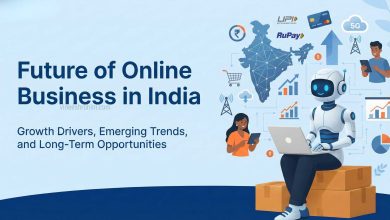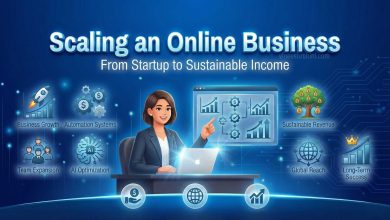Why Ecommerce is The Future ? : Comprehensive Guide 2024
Why Ecommerce is The Future : In recent years, ecommerce has reshaped how we shop, work, and connect. The trend has escalated significantly as digital technologies become more advanced, customers demand more convenient shopping experiences, and businesses adapt to a more globalized marketplace. Ecommerce’s reach now extends beyond mere online transactions; it has integrated into almost every facet of our daily lives, influencing how we perceive and participate in the economy.
Table of Contents
This essay will explore why ecommerce is becoming the cornerstone of the future economy, delving into factors such as technology, consumer behavior, sustainability, global accessibility, and market opportunities.
1. The Technological Backbone of Ecommerce

Technology fuels ecommerce innovation, allowing businesses to operate efficiently, reach broader audiences, and personalize the shopping experience. At its core, ecommerce relies on technological advancements that make it more accessible, secure, and interactive.
a. AI and Machine Learning
Artificial intelligence (AI) and machine learning (ML) are revolutionizing ecommerce by personalizing shopping experiences and optimizing product recommendations. Platforms like Amazon and Netflix use AI to analyze customer data, showing users products or content that closely match their interests.
Also Read : SolidGigs Review : Can You Make Money Online
This personalized approach enhances user satisfaction, leading to higher conversion rates and customer loyalty.
b. Augmented Reality (AR) and Virtual Reality (VR)
Augmented reality (AR) and virtual reality (VR) technologies provide immersive shopping experiences that bridge the gap between physical and digital retail. For instance, furniture and fashion retailers now allow customers to “try before they buy” through virtual fitting rooms or room visualization tools. IKEA’s AR app, for example, lets customers visualize how furniture will look in their homes, increasing purchase confidence and reducing return rates.
c. Mobile Commerce (M-commerce)
Smartphones and tablets have become integral to ecommerce. Mobile commerce, or m-commerce, is a rapidly growing segment, enabling consumers to shop on the go. With features like one-click payment, QR code integration, and mobile-friendly web designs, ecommerce businesses can offer seamless experiences that fit modern lifestyles.
d. Blockchain and Cryptocurrency
Blockchain technology offers promising applications in ecommerce by increasing transparency and security in transactions. Cryptocurrencies like Bitcoin and Ethereum, while not yet mainstream for all ecommerce platforms, are being accepted by some retailers and offer a decentralized payment option. Blockchain can also improve supply chain transparency, making it easier for consumers to verify the authenticity and origins of their purchases.
2. Shifting Consumer Behaviors and Expectations
As technology drives ecommerce, consumer behavior has evolved to align with the new digital economy, creating a symbiotic relationship between innovation and demand. Customers today prioritize convenience, personalization, and fast delivery, which ecommerce platforms are increasingly providing.
a. Convenience and Accessibility
Ecommerce platforms enable consumers to shop 24/7, removing the restrictions of traditional retail hours. This convenience is especially valuable for those in remote areas or with busy schedules. The ease of shopping online—especially with features like voice search, mobile wallets, and one-click ordering—makes ecommerce an attractive alternative to traditional shopping.
b. Global Reach and Diversity of Choices
Ecommerce breaks down geographical barriers, providing consumers with access to products from around the world. Cross-border ecommerce platforms like Alibaba and Amazon offer a diverse range of products that may not be available in local stores. This accessibility not only benefits consumers but also helps small businesses reach international markets.
c. Social Media Integration
The influence of social media has been instrumental in shaping modern shopping habits. Platforms like Instagram, Facebook, and TikTok have become digital marketplaces where brands can engage directly with consumers. Influencer marketing and social commerce (where users can shop directly within social media apps) have also made ecommerce more interactive and engaging, driving more online purchases.
3. Sustainability and the Ecommerce Ecosystem
Environmental concerns are reshaping the ecommerce industry, with both consumers and businesses prioritizing sustainability. Sustainable ecommerce practices are not only a response to climate change concerns but also a marketing advantage in attracting eco-conscious consumers.
a. Reduced Carbon Footprint
Ecommerce allows companies to operate without physical retail spaces, reducing overhead costs and carbon footprints associated with lighting, heating, and maintaining storefronts. Furthermore, ecommerce companies are optimizing supply chains to reduce emissions, using algorithms to manage inventory and logistics more efficiently.
b. Eco-Friendly Packaging and Practices
Sustainable packaging is an increasingly important aspect of ecommerce. Many companies now use recycled, biodegradable, or minimal packaging to reduce waste. Additionally, ecommerce companies are promoting “green” delivery options, such as carbon-neutral shipping, which appeals to environmentally conscious consumers.
c. Circular Economy and Secondhand Marketplaces
Ecommerce platforms are now enabling circular economy models, encouraging consumers to buy, sell, or recycle used products. Platforms like ThredUp and eBay allow consumers to participate in the secondhand market, supporting a more sustainable consumer culture by extending the lifespan of products.
4. The Role of Ecommerce in Global Economic Expansion

Ecommerce is a powerful driver of global economic expansion, allowing businesses of all sizes to tap into international markets. It fosters economic growth, creates jobs, and provides new opportunities for entrepreneurs worldwide.
a. Small Businesses and Startups
Ecommerce platforms like Shopify and Etsy empower small businesses and artisans to reach global customers without a significant upfront investment in physical infrastructure. This democratization of commerce allows entrepreneurs with limited resources to compete in the market and scale quickly.
b. Job Creation and the Gig Economy
The rise of ecommerce has generated a variety of job opportunities, particularly in logistics, customer service, and digital marketing. Additionally, the gig economy has grown alongside ecommerce, offering flexible work options for freelancers, remote workers, and gig workers, further driving economic growth.
c. Expanding Emerging Markets
Ecommerce is particularly transformative for emerging markets, where access to physical stores and traditional financial services may be limited. Digital payment systems and ecommerce platforms enable consumers in developing countries to shop online, often for the first time. Platforms like Jumia in Africa or MercadoLibre in Latin America demonstrate how ecommerce can accelerate economic development in these regions.
5. Challenges and Future Outlook
While the future of ecommerce is promising, challenges remain. Security concerns, regulatory hurdles, and supply chain issues are ongoing obstacles that the industry must address.
a. Data Security and Privacy Concerns
With more transactions and data exchanges happening online, data security and privacy are top priorities for ecommerce. Cybersecurity measures, encryption, and strict data regulations (such as GDPR) are necessary to protect consumers and foster trust in online transactions.
b. Logistics and Supply Chain Management
Ecommerce growth has placed immense pressure on logistics and supply chains. Ensuring timely and cost-effective delivery is a significant challenge, particularly for cross-border transactions. Technological advancements in AI and robotics offer promising solutions to streamline warehouse operations and last-mile delivery, but significant investment is still needed.
c. Regulatory Landscape
The regulatory environment for ecommerce is complex, especially for cross-border transactions. Different countries have varying regulations on data privacy, taxes, and consumer protection, making it challenging for ecommerce businesses to navigate compliance requirements.
Why Ecommerce is The Future : Conclusion

Ecommerce’s rapid rise is transforming economies and redefining consumer expectations, driven by technology, convenience, and the global reach it offers. As the industry continues to evolve, ecommerce will likely become even more integrated into daily life, providing consumers with enhanced shopping experiences, personalized options, and sustainable solutions. Businesses, too, will benefit from ecommerce’s potential to drive growth, foster innovation, and expand to global markets.
Buy Now : Ecommerce Website With 100 Products
The future of ecommerce is promising, yet demands attention to areas like cybersecurity, logistics, and regulatory compliance. With strategic investments in technology and sustainability, ecommerce can continue to thrive, shaping the future of how we engage with goods, services, and information. As it does, it will cement its place as the new cornerstone of the global economy, paving the way for a more interconnected and convenient shopping landscape for consumers and businesses alike.
Keywords : Why Ecommerce is The Future – Why Ecommerce is The Future 2024 – Why Ecommerce is The Future 2025



